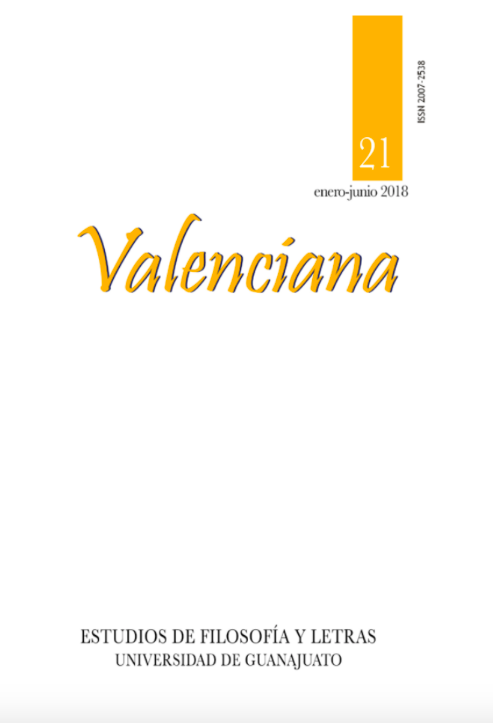The presence of God in the interior castle. On the complementarity of mystic anthropology of Santa Teresa de Jesus and Edith Stein’s phenomenological anthropology
DOI:
https://doi.org/10.15174/rv.v0i21.347Abstract
The aim of this article is showing the most important coincidences between Santa Teresa de Jesus’s mystic anthropology and Edith Stein’s phenomenological anthropology, about soul’s comprehension, in order to exhibit their agreement. This meditation is philosophical anthropology by its object; phenomenology, by its method, and hermeneutics, because the analysis is directed to three textual constructions: The interior castle (written by Santa Teresa de Jesús), Finite and eternal Being and Soul’s Castle (written by E. Stein). The thesis I ́ll try to prove is: if the human essence is defined by the opening to the mystery of God, the integral comprehension of human being should consider the mystical testimonies.References
Agustín, San, 2013, Confesiones (trad. Eugenio de Zeballos), Palabra: Madrid, 555.
Andueza, María, 1985, Agua y luz en Santa Teresa, Universidad Nacional Autónoma de México: México, pp. 216.
Aristóteles, 2016, Acerca del alma (trad. T. Calvo Martínez), Gredos: Madrid.
Aristóteles, 1994, “Categorías”, en Tratados de Lógica I. (tr. Miguel Candel), Gredos: Madrid, 29-77.
Avenatti de Palumbo, Cecilia, 2009, “La figura de la Interioridad como Lenguaje Estético– Dramático Mediador entre la Literatura Argentina y la Teología”, en Congreso Hacia el Bicentenario (2010-2016). Memoria, Identidad y Reconciliación. Educa: Buenos Aires, xxx
Caballero, José Luis, 2010, “Ejes transversales del pensamiento de Edith Stein”, en Teología y Vida, No. 39, 39-58.
De Aquino, Santo Tomás, 2014, Suma Teológica I. (trad. Francisco Barbado Viejo), Biblioteca de Autores Cristianos, Madrid, 976.
De Cós, Julián, 2013, “La espiritualidad de Santa Teresa de Jesús. 3. Primeros pasos de la oración mística”, en Vida Sobrenatural. Revista de Teología Mística, No. 685, 40-54.
De Jesús, Santa Teresa, 2004, “Las moradas del castillo interior”, en Obras Completas. Monte Carmelo: Burgos.
___________________, 1998, Libro de la Vida, Rei, México, 483.
Eckhart, Meister, 2008, El fruto de la nada (trad. Amador Vega Esquerra), Madrid, Siruela, 232.
Fanning. Steven, 2001, “Chapter IV. Mystics in Early Modern Europe”, en Mystics of the Christian tradition”, Routledge, London-New York, 139-174.
García-Baró, Miguel, 1999, Mundo y Vida. La práctica de la fenomenología, Trotta, Madrid, 320.
González de Cardenal, Olegario, 2012, Cristianismo y Mística, Buenos Aires: Educa, 360.
Guardans, Teresa, 2009, La verdad del silencio. Por los caminos del asombro, Herder, Barcelona, 304.
Herráiz, Maximiliano, 2003, La oración, historia de amistad, Editorial de Espiritualidad, Madrid, 205.
Husserl, Edmund, 2013, Ideas relativas a una fenomenología pura y una filosofía fenomenológica. Libro primero: Introducción general a la fenomenología pura, Fondo de Cultura Económica- UNAM, México, 812.
Meis, Anneliese. 2013, “Gracia desbordante y teología práctica, según Edith Stein, Die Seelenburg”, en Teología y Vida, No. LVI, 115-156.
Martín Velasco, Juan, 2007, “«Búscame en ti- Búscame en ti». Descubrimiento del hombre y descubrimiento de Dios es santa Teresa”, en La experiencia cristiana de Dios, Trotta, España, 119-148.
Piper, Josef, 1958, Happiness and Contemplation, USA, Pantheon, 125.
Pikaza, Xabier, 1989, Para vivir la oración cristiana, Verbo Divino, España, 222.
Ramón, Rafael, 1992, La recepción árabe del De anima de Aristóteles: Al-Kindi y Al-Farabi, Consejo Superior de Investigaciones Científicas, Madrid, XXX.
Royo Marín, Antonio., 2002. Los grandes maestros de la vida espiritual, Biblioteca de Autores Cristianos, Madrid, 498
Sancho, Francisco, 1998, “Filosofía y vida: el itinerario filosófico de Edith Stein”, en Anuario Filosófico, No. 31, 665-687.
Stein, Edith, 1999, “El castillo del alma” (ed. Frncisco Javier Sancho), en Escritos espirituales, Biblioteca de Autores Cristianos, Madrid, 39-66.
___________, 2002, Escritos esenciales (trad. John Sullivan), Sal Terrae, Santander, 207.
___________, 2000, La ciencia de la cruz (tr. Lino Aquesolo Olibares), Monte Carmelo, Burgos, 380.
___________, 1998, La estructura de la persona humana (trad. José Mardomingo), Biblioteca de Autores Cristianos, Madrid, xxxx.
__________, 1996, Ser finito y ser eterno. Ensayo de una ascensión al sentido del ser (trad. Alberto Pérez Monroy), Fondo de Cultura Económica, México, 549.
Underhill, Evelyn, 2006, La mística. Estudio de la naturaleza y desarrollo de la conciencia espiritual (trad. Carlos Martín Ramírez), Trotta-Centro Internacional de Estudios Místicos, España, 594.
Zambrano, María, 1987, Hacia un saber sobre el alma, Alianza, Madrid.
Published
How to Cite
Issue
Section
License
Author(s) who publish in this journal do accept the next conditions:
According to copyright regulations, Valenciana does recognize and respect the authors’ moral right, as well as the right of property, which will be assigned to the journal for its diffusion in open access.
Valenciana does not charge authors for the submission, editorial process or publication in the journal.
All texts published and distributed by Valenciana (without exception) are supported by the license Creative Commons Attribution-NonCommercial 4.0 International (CC BY-NC 4.0), which allows third parties to use the publication as long as they mention the author and the first publication.
Authors can make other independent and additional contractual agreements for the non-exclusive use of his article published in Valenciana (e.g. including it in an institutional repository or in printed/electronic media), as long as it is explicitly clarified that the article was published for the first time in this journal.
For these purposes, authors must sign and send the letter of submission and copyright transfer form in a PDF file to this email address: revistavalenciana@gmail.com
This journal is under a license by Creative Commons Atribución-NoComercial-SinDerivadas 4.0 Internacional (CC BY-NC-ND 4.0)).













